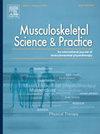Correlation of absolute and relative limb differences in Y-balance test and asymmetry indices of CMJ, SJ and IMTP
IF 2.2
3区 医学
Q1 REHABILITATION
引用次数: 0
Abstract
Objective
Determine the relationship between Y-Balance Test (YBT) and force platform-based assessments, including squat jump (SJ), countermovement jump (CMJ), and isometric mid-thigh pull (IMTP), to evaluate lower limb stability and asymmetry.
Method
Sixty-one recruited active professional firefighters were assessed for YBT absolute limb differences (anterior, posteromedial, and posterolateral directions) using the YBT classic formula or a force platform built-in formula, and for asymmetry indices of CMJ, SJ and IMTP derived from the force platform.
Results
The absolute limb differences in YBT anterior (YBT-A) showed a moderate correlation (r > 0.4) with asymmetry indices of SJ concentric peak force (SJ-CPF), IMTP peak force component (IMTP-PFC), and IMTP peak force (IMTP-PF). Subsequently, limb relative differences for YBT-A were calculated using the built-in formula of the force platform, which also showed a moderate correlation (r > 0.4) with asymmetry indices of SJ-CPF, IMTP-PFC, and IMTP-PF. However, when considering either absolute or relative differences, YBT posteromedial asymmetry (YBT-PMA) or YBT posterolateral asymmetry (YBT-PLA) showed weak or negative correlations with asymmetry indices derived from the force platform.
Conclusion
This study demonstrated that YBT anterior asymmetry (YBT-AA) calculated by using either the YBT classic formula or the built-in formula of the force platform, showed a moderate correlation with asymmetry indices derived from the force platform. This study provides clinicians and researchers with different test methods for assessing lower limb stability.
CMJ、SJ和IMTP的y -平衡测试绝对和相对肢体差异与不对称指数的相关性
目的确定y -平衡测试(YBT)与基于力平台的评估的关系,包括深蹲跳(SJ)、反动作跳(CMJ)和等距大腿中部牵拉(IMTP),以评估下肢稳定性和不对称性。方法采用YBT经典公式或内置力平台公式评估61名现役职业消防员的YBT绝对肢体(前、后内侧和后外侧)差异,以及由力平台得出的CMJ、SJ和IMTP不对称指数。结果前YBT (YBT- a)绝对肢体差异呈中等相关性(r >;0.4),不对称指数为SJ同心峰值力(SJ- cpf)、IMTP峰值力分量(IMTP- pfc)和IMTP峰值力(IMTP- pf)。随后,利用力平台的内置公式计算YBT-A的肢体相对差值,也显示出中等相关性(r >;0.4),不对称指数为SJ-CPF、IMTP-PFC和IMTP-PF。然而,当考虑绝对或相对差异时,YBT后内侧不对称(YBT- pma)或YBT后外侧不对称(YBT- pla)与力平台得出的不对称指数呈弱相关或负相关。结论本研究表明,无论是使用YBT经典公式还是使用力平台内置公式计算的YBT前牙不对称性(YBT- aa),都与力平台得出的不对称性指标有一定的相关性。本研究为临床医生和研究人员提供了评估下肢稳定性的不同测试方法。
本文章由计算机程序翻译,如有差异,请以英文原文为准。
求助全文
约1分钟内获得全文
求助全文
来源期刊

Musculoskeletal Science and Practice
Health Professions-Physical Therapy, Sports Therapy and Rehabilitation
CiteScore
4.10
自引率
8.70%
发文量
152
审稿时长
48 days
期刊介绍:
Musculoskeletal Science & Practice, international journal of musculoskeletal physiotherapy, is a peer-reviewed international journal (previously Manual Therapy), publishing high quality original research, review and Masterclass articles that contribute to improving the clinical understanding of appropriate care processes for musculoskeletal disorders. The journal publishes articles that influence or add to the body of evidence on diagnostic and therapeutic processes, patient centered care, guidelines for musculoskeletal therapeutics and theoretical models that support developments in assessment, diagnosis, clinical reasoning and interventions.
 求助内容:
求助内容: 应助结果提醒方式:
应助结果提醒方式:


